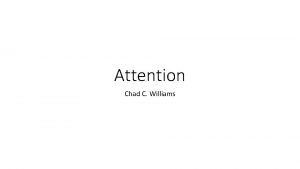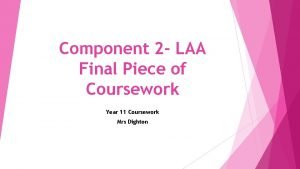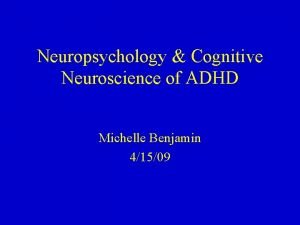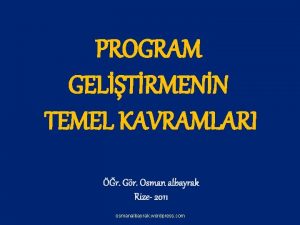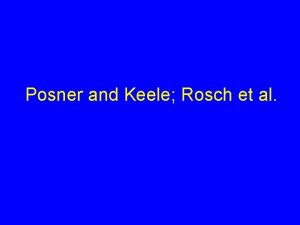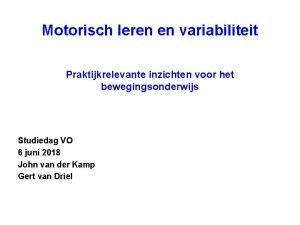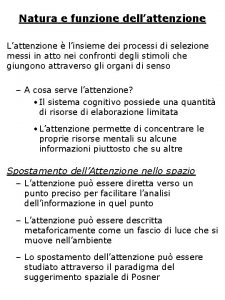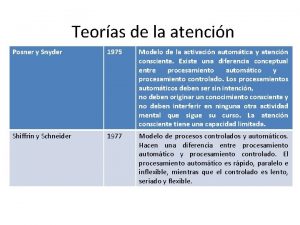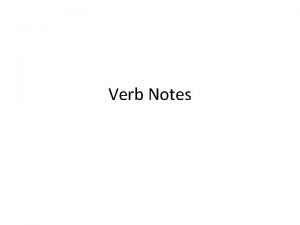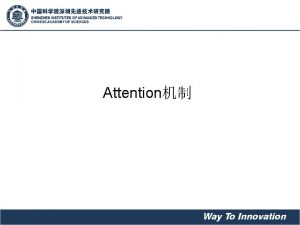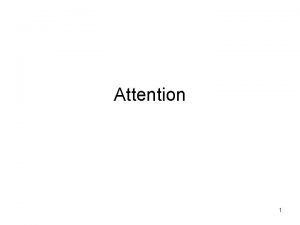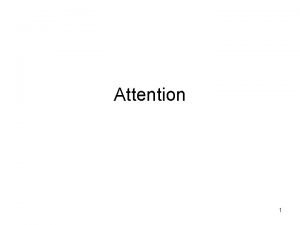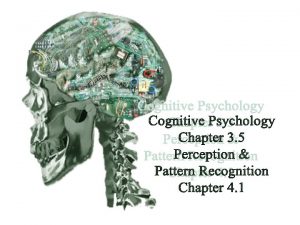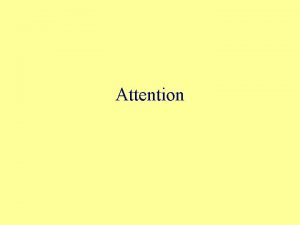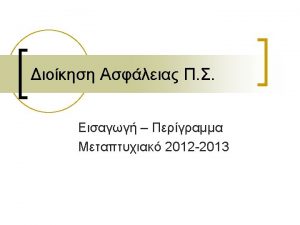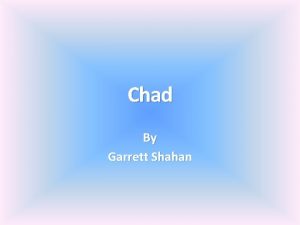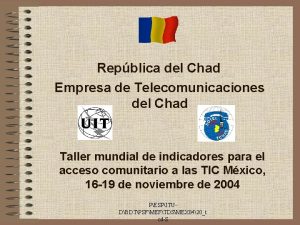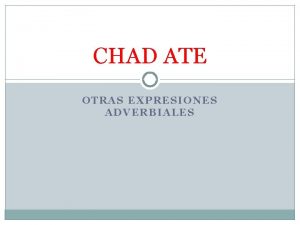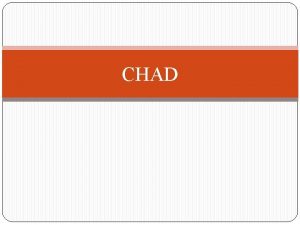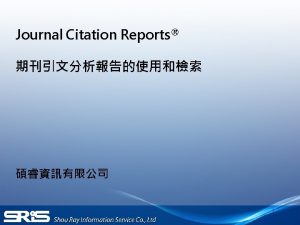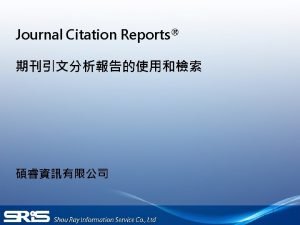Attention Chad C Williams Posner 1980 Quarterly Journal


























- Slides: 26

Attention Chad C. Williams




Posner (1980). Quarterly Journal of Experimental Psychology

Attention • Alerting: Signal of preparatory attentional need • Orienting: Control of attention towards location or modality • Executive (Focal Attention): Top down influence to maintain important information Petersen and Posner. (2012). Annual Review of Neuroscience.

Posner (1980). Quarterly Journal of Experimental Psychology

Composition of Attention • Multi-faceted mechanism, with distinct neural localization and neurotransmitter influence • Each component of attention is thought to be a network Petersen and Posner. (2012). Annual Review of Neuroscience.

Alerting • A ‘when’ signal. • Using a warning signal to switch from a resting state in favour of a preparatory state. • Diverse system of brain regions, guided by norepinephrine. • Example of Task: Prime participants that the target is coming improves reaction times. Petersen and Posner. (2012). Annual Review of Neuroscience.

Orienting • A ‘where’ signal. • Used to prioritize information (e. g. , a target) while ignoring distractors. • Can be dynamic, where orientation must be disengaged and reoriented. • Also functions to orientate across modalities. • Diverse system of brain regions, guided by acetylcholine. • Example of Task: Present blue and green coloured circles where blue is the target. In presence of a distracting red circle, reaction times decrease. Petersen and Posner. (2012). Annual Review of Neuroscience.

Executive • A ‘processing’ signal. • Detecting/Processes target which will use limited cognitive resources. • Generally – conflict monitoring and cognitive control in the context of attentional focus. • Top-down regulation. • Dynamic involvement of cognition. • Task switching (instructions), elongated top-down influence, feedback processing. • Diverse system of brain regions, guided by serotonin. • Example of Task: Flanker Task Petersen and Posner. (2012). Annual Review of Neuroscience.

Anatomy of Alerting Parietal Cortex Lateral Frontal Cortex Locus Coeruleus Heavily right hemisphere Petersen and Posner. (2012). Annual Review of Neuroscience.

Anatomy of Alerting Locus Coeruleus: Source of Norepinephrine Frontal Cortex: Dorsal stream – preparing for orientation Parietal Areas: Dorsal stream – preparing for orientation

Ventral Frontal Cortex Temporoparietal junction Anatomy of Orienting Superior Parietal Lobule Interparietal Sulcus Frontal Eye Field Basal Forebrain Petersen and Posner. (2012). Annual Review of Neuroscience.

Anatomy of Orienting Basal Forebrain: Source of Acetylcholine Frontal Eye Field: Dorsal Stream – controlling the location of covert attention Interparietal Sulcus: Dorsal Stream – controlling the location of attention Ventral Frontal Cortex: Involved in disengagement of attention Temporoparietal Junction: Involved in reorientation of attention Superior Parietal Lobe: Shifting attention to a target.

Anatomy of Executive Parietal Cortex ACC Medial Frontal Cortex Lateral Anterior Frontal Insula Cortex Petersen and Posner. (2012). Annual Review of Neuroscience.

Anatomy of Executive ACC: Target detection and awareness. Conflict detection/ Inhibition of salient non-targets. Sustained maintenance Anterior Insula: Sustained maintenance Medial Frontal Cortex: Target detection and awareness. Sustained maintenance. Lateral Frontal Cortex: Conflict monitoring, goal-orientation Parietal Cortex: Goal-orientation

Alterting + Orienting + Executive Alerting Orienting Executive ACC Ventral Frontal Cortex Parietal Temporoparietal junction Cortex Anterior Insula Frontal Eye Field Locus Coeruleus Medial Frontal Cortex Basal Forebrain Lateral Frontal Cortex Superior Parietal Lobule Interparietal Sulcus Petersen and Posner. (2012). Annual Review of Neuroscience.

Neurotransmitter of Alerting (Norepinephrine) Petersen and Posner. (2012). Annual Review of Neuroscience.

Neurotransmitter of Orienting (Acetylcholine) Petersen and Posner. (2012). Annual Review of Neuroscience.

Neurotransmitter of Executive (Serotonin) Pennanen (2013). Nautre Neuroscience

Dissociative Neurotransmitters Research Question: Which neurotransmitters are involved in alerting and orienting, and are they dissociable? Task: Cued detection task Manipulation: Norepinephrine (NE)/ Acetylcholine (AC) blockers Measurement: Reaction time Results: • NE blocker: Increases alerting effect, not orienting effect • AC blocker: Increases orienting effect, not alerting effect Conclusion: Independent systems governed by different NTs Davidson & Marrocco (2000). Journal of Neurophysiology

Task Alerting and orienting Alerting w/o orienting No warning or orienting

Task Alerting Effect: Double cue – No cue Orienting Effect: Valid cue – Double cue

Dissociative Neurotransmitters Research Question: Which neurotransmitters are involved in alerting and orienting, and are they dissociable? Task: Cued detection task Manipulation: Norepinephrine (NE)/ Acetylcholine (AC) blockers Measurement: Reaction time Results: • NE blocker: Increases alerting effect, not orienting effect • AC blocker: Increases orienting effect, not alerting effect Conclusion: Independent systems governed by different NTs Davidson & Marrocco (2000). Journal of Neurophysiology

 Chad posner
Chad posner Robbie williams janet williams
Robbie williams janet williams Sam and verna williams
Sam and verna williams Andy williams robert williams
Andy williams robert williams Michelle benjamin phd
Michelle benjamin phd Posner'ın eğitim programı sınıflaması
Posner'ın eğitim programı sınıflaması Paradigma di posner
Paradigma di posner Michael i posner
Michael i posner Posner and keele
Posner and keele Prof dr halil ateş
Prof dr halil ateş Fitts en posner
Fitts en posner Paradigma di posner
Paradigma di posner Kouzes and posner 2002
Kouzes and posner 2002 Posner psicologia
Posner psicologia Paradigma di posner
Paradigma di posner Modelo de posner y snyder
Modelo de posner y snyder Gordon saxe
Gordon saxe Chad meyerhoefer
Chad meyerhoefer Chad topaz
Chad topaz Chad eggerman
Chad eggerman Chad blight
Chad blight Chad ulven
Chad ulven Rill erosion
Rill erosion Chad ostlund
Chad ostlund Chad b swim
Chad b swim Chad rikansrud
Chad rikansrud Chad gifford columbia
Chad gifford columbia
